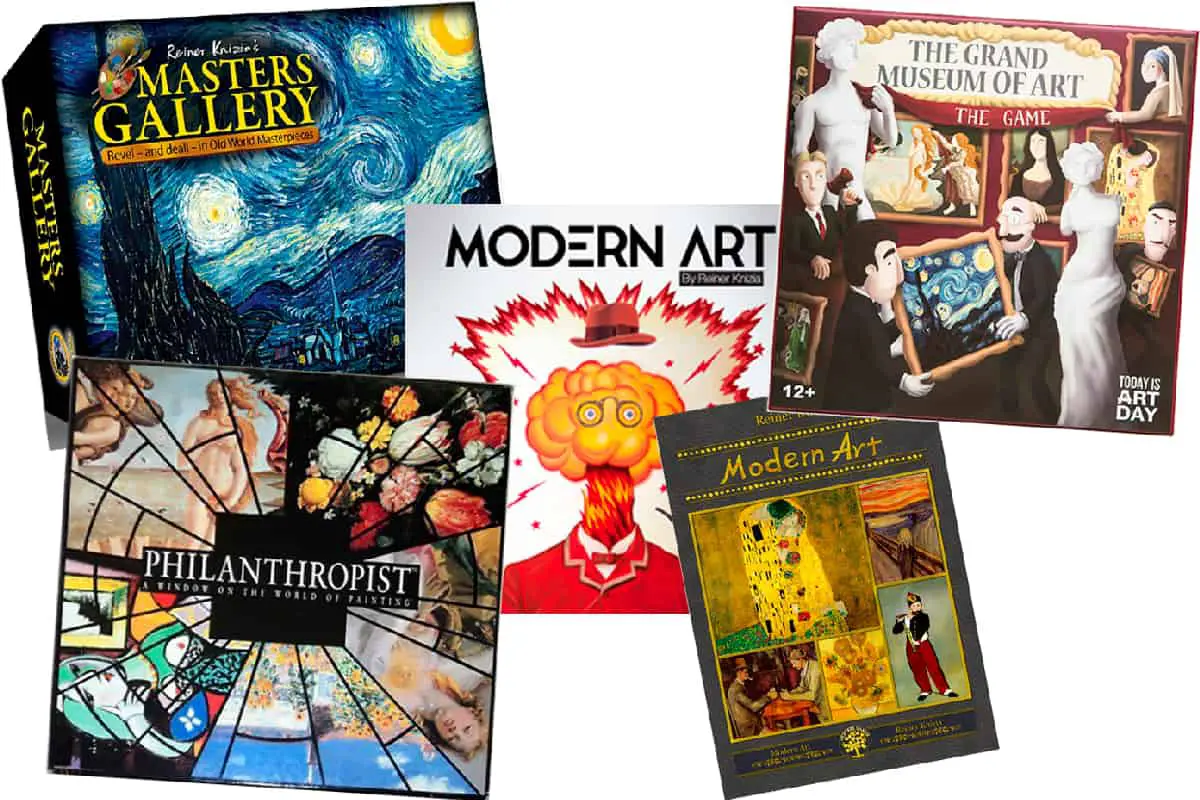This post contains affiliate links.
To complete my series of posts about art & art history games here is “the” one about art history BOARD games! It is not an easy one, as there are lots of art-themed board games, but few that truly have an educational value for teaching art or art history. So I decided to remain on the safe side and keep the list short.
Few board games (for card games see my other posts) truly have an educational value for teaching art history: “Modern Art” is a famous “auction game”, while “The Grand Museum of Art” is a family game and “Philanthropist” is a trivia-based board game.
The two first games completely differ from the two last ones and will please completely different people. In the explanations below you will clearly understand why.
4 Auction Board Games That Teach Art History
Games in this category are considered by boardgame enthusiasts as “real games” (a real strategy is necessary for the players to win). They are more demanding than “family games” or “trivia games“. So do play them with teenagers, but not with primary school children.
“Modern Art” by Reiner Knizia
Modern Art by Reiner Knizia is considered by many people as the best “auction game” of all time (and Reiner is the most prolific game author of all time!). There are several versions of the game by different publishers (cheap and expensive ones, and versions with different choices of artwork).
The principle of the game is that each player is a museum curator. Using different auction styles, you buy and sell artwork and try to get the best deals possible.
So here are your alternatives:
Modern Art (CMON)

This is the current standard version of Modern Art . It is affordable, and even better value for your money now that the game includes a wooden auctioneer’s hammer (in the latest edition)!
. It is affordable, and even better value for your money now that the game includes a wooden auctioneer’s hammer (in the latest edition)!
Here are some main characteristics of the game:
- 2-5 players
- Age: 14 and up
- Lasts about 60 minutes
- 5 different types of auctions, each one requiring a different strategy to get the best price (each of the auction mechanisms is not difficult to understand at all) – there is fake money in the game so as to make the auctions seamless
- The market value of an artist’s work is determined by how many of their paintings have been sold.
- After four rounds of auctions, the player who has the most money wins.
- Results are very difficult to predict, which is a reason why the game is really funny and so popular.
- The artwork cards are oversized and beautifully printed
This version includes 70 artworks from 5 contemporary artists (one card per artwork): Manuel Carvalho, Ramon Martins, Daniel Melim, Rafael Silveira, Sigrid Thaler. The rulebook contains biographies about each artist and examples of their works.
The downside:
- If you want a game with better-known modern art, you can try:
- The version of Modern Art by Dice Tree Games that features 140 artworks by Manet, Cezanne, Gogh, Munch, Klimt, van Eyck, Arcimboldo, da Vinci, Raffaello & Botticelli
- “Masters Gallery” which is quite similar to “Modern Art” and features artworks by Van Gogh, Monet, Vermeer, Degas, and Renoir.
- The game requires that you estimate the potential gains and values of the artworks in your head. Players having difficulties juggling with numbers will feel handicapped and not find it fun.
Modern Art (Oink Games)

The Oink Games version of Modern Art has a very clean design with a different set of artists including Mondrian. It is made by a Japanese publisher and is available in French and German.
Modern Art (Dice Tree Games)
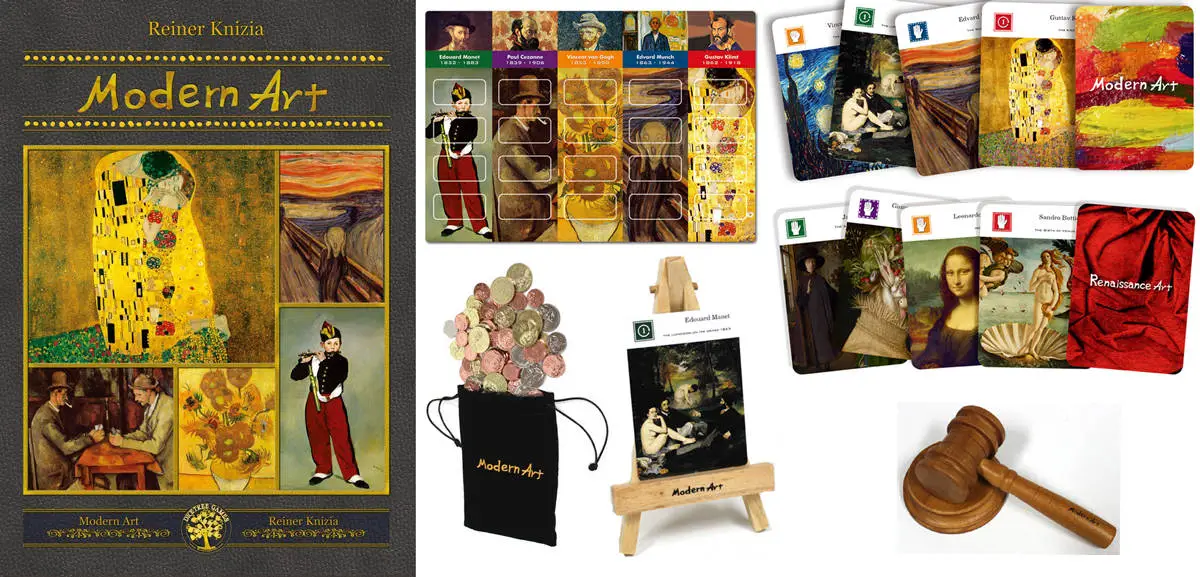
The version of Modern Art from DiceTree Games features 140 paintings from modern (19th/20th century) and renaissance artists in two sets:
features 140 paintings from modern (19th/20th century) and renaissance artists in two sets:
- 70 artworks from Manet, Cezanne, Gogh, Munch, and Klimt
- 70 artworks from van Eyck, Arcimboldo, da Vinci, Raffaello, Botticelli (in a previous version, it was with 5 Korean traditional artists)
It is the most luxurious (and costly) version of the game (about double the price). The game was intended originally for the Korean market, but the game includes auction summary cards in Dutch, English, French, German, Italian, Japanese, Polish and Spanish – so that you remember easily how each type of auction works.
Masters Gallery (Eagle-Gryphon Games)

Masters Gallery is based on the classic “Modern Art” board game, but without auctions (so sorry to have put it in the “auction games” section, this is because of the similarity with “Modern Art“). Here are the other important differences:
is based on the classic “Modern Art” board game, but without auctions (so sorry to have put it in the “auction games” section, this is because of the similarity with “Modern Art“). Here are the other important differences:
- Simpler: works with children 10 Years and up (less complex strategy)
- Quicker: games last about 30 minutes
- 30 works of art by Van Gogh, Renoir, Monet, Degas, and Vermeer (95 cards so each artwork appears several times) + 5 Artist cards (just the name of the artist & a masterpiece on them)
- 2 to 5 players
The game’s strategy is very interesting from the gaming point of view and thus works very well for older children and for gamers as well.
By the way, Eagle-Gryphon Games also proposes for almost a third of the price “Modern Art – The Card Game” which is exactly the same game as “Masters Gallery”, but in a smaller box and with 5 “unrenowned” modern artists rather than 5 classic masters. That tells something about the level of the copyright fees you have to pay to license art that is in public museums. So if you are interested only by the gameplay, and not by Van Gogh, Renoir, Monet, Degas, and Vermeer, you might as well prefer “Modern Art – The Card Game”.
It would be a better educational game if it did not have a major flaw: as you can see, artworks are printed on colored cards (5 colors: orange, red, yellow, green, purple) and in small size. This is a bad idea as color perception is heavily influenced by the color that surrounds (entire optical illusions are based on this). This super thick surrounding yellow, green, blue or red border spoils the artwork. There is a reason why artworks are put in well-designed frames of neutral color. This problem could have easily been avoided by replacing the 5 colors by 5 icons.
Because of this design flaw, I cannot really recommend this game in an educational setting (at home or at school), even though its shorter duration would make it a more viable possibility at school than “Modern Art”. But if you don’t mind having cards like this it is a very good game.
Two Family Board Games That Teach Art History
What I include here are games that:
- Are great to play at home with your children or even at school if you find the time to include them in your teaching. They are simple to understand and explain, do not last too long, are not overly competitive and have some educational value.
- But are NOT considered good games by board games enthusiasts, because they are not strategic enough (you do not really need a clever strategy to win), or a board enthusiast might find them plain boring (little possibility to reverse situations until the end for example).
If you look at their ratings on BGG, they will be awful, but customer ratings on Amazon might be sky-high :-). Don’t let the geeks impress you, “fun” for a 9-year-old child is not at all the same thing as for a 30-year-old game geek – these games will be perfect to play at home.
The Grand Museum of Art (Today is Art Day)
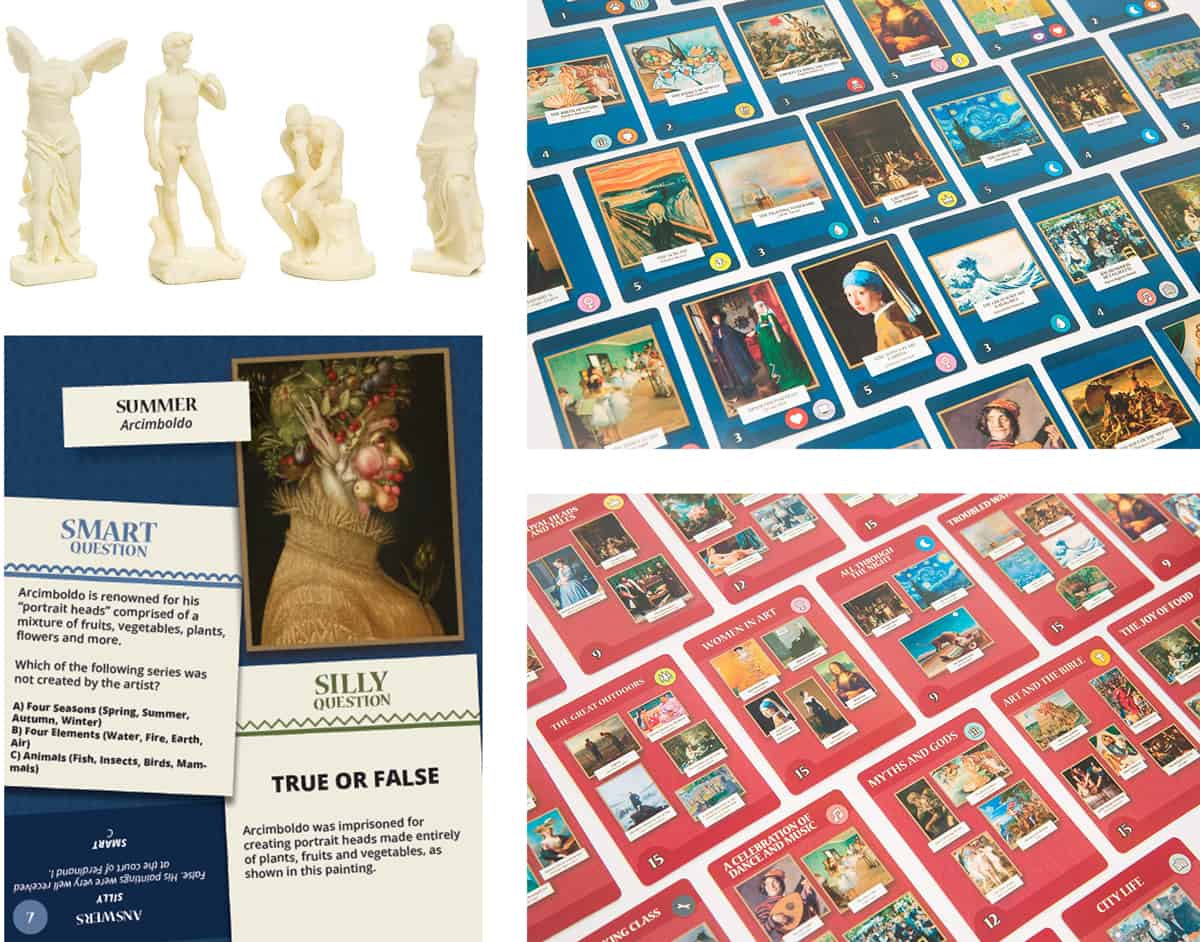
2-4 players
Duration: 60 minutes
Age: 12+ according to the publisher, but in fact really OK for 10 year-olds (with a little help on trivia questions)
The Grand Museum of Art is a game with almost no strategy (you roll a dice, progress on the board, and perform the actions on cards you draw, etc…). This makes it a terrible game for board game nerd, but a good family game because it is very accessible to rather young children, and it adds educational value with the artworks and some trivia questions around them.
is a game with almost no strategy (you roll a dice, progress on the board, and perform the actions on cards you draw, etc…). This makes it a terrible game for board game nerd, but a good family game because it is very accessible to rather young children, and it adds educational value with the artworks and some trivia questions around them.
The players collect works of art for exhibitions. They make exchanges, bid at auctions, or steal artwork for their collection. They answer trivia questions.
The game contains:
- 65 artwork cards that you collect to get points, all masterpieces by famous artists
- 4 superb tokens (one per player) of Michelangelo’s David, Winged Victory of Samothrace, Rodin’s Thinker & Venus de Milo. They enhance the fun of the game just by themselves.
- A game board: You progress on it by rolling a dice. According to where you land, you perform one the following actions: Collect an artwork, exchange an artwork, steal an artwork, bid at auction (result is given by a dice)
- A trivia book & a game rule
- 20 Exhibition cards: you use them to complete thematic exhibitions and get points
- 24 Special cards
So I really recommend this game at home. It can be played by parents and children together, as the winner is almost entirely determined by luck, and not by any specific strategy of knowledge of art; the trivia questions are rather easy, and once you played once or twice you will know the answers.
The duration of the game (1 hour) makes it less useful for schools, but it can definitely be used at school either in a simplified form or if you have time for extended play.
Art Shark (Birdcage Press)
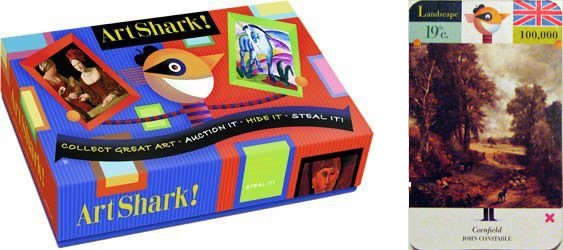
Warning: This game is not anymore in Birdcage Press’s catalog, meaning that it is discontinued, but there are still remaining games in stock that you can find online.
Art Shark could have been a really good educational game if some of its problems had been solved during its design. If you do not mind its shortcomings it can be a good family game.
could have been a really good educational game if some of its problems had been solved during its design. If you do not mind its shortcomings it can be a good family game.
The positive points:
- The 64 artwork cards are great: large print of the artwork, plus a lot of relevant information on the card in an efficient way (century, genre, country, title of the artwork, artist name)
- Good leaflet that summarizes each century’s artworks, showing them together!
- The mechanism of the game is rather good, with some variety (auctions, steal art, gallery + vault), and not too complex IF you take the time to clarify it (see below), so that it is usable from 8 year-olds (or preferable 10 Year-olds)
The problems:
- The rules are not well explained. You will have to complete the rule with your own additions whenever there is ambiguity. This can be overcome by imaginative people, but many people do have real difficulties with unclear rules and get stuck.
- There is no “fake money” included in the game (like in Modern Masters for example). So you need to keep track of the money exchanged during the game on a scoresheet; the scoresheet is not provided so you have to create it yourself or download online.
Provided that these problems are not a “no-go” for you, you can absolutely enjoy playing this game at home. As “The grand Museum of Art”, it might be too long for regular use in the classroom but can be used at school in other settings (or by simplifying the game and taking the opportunity of the cards and the leaflet which are great tools).
3 Quiz & Trivia Board Games That Teach Art History
Philanthropist – National Gallery (Mecenes)
The game is out of print, but you can find it on Ebay .
.
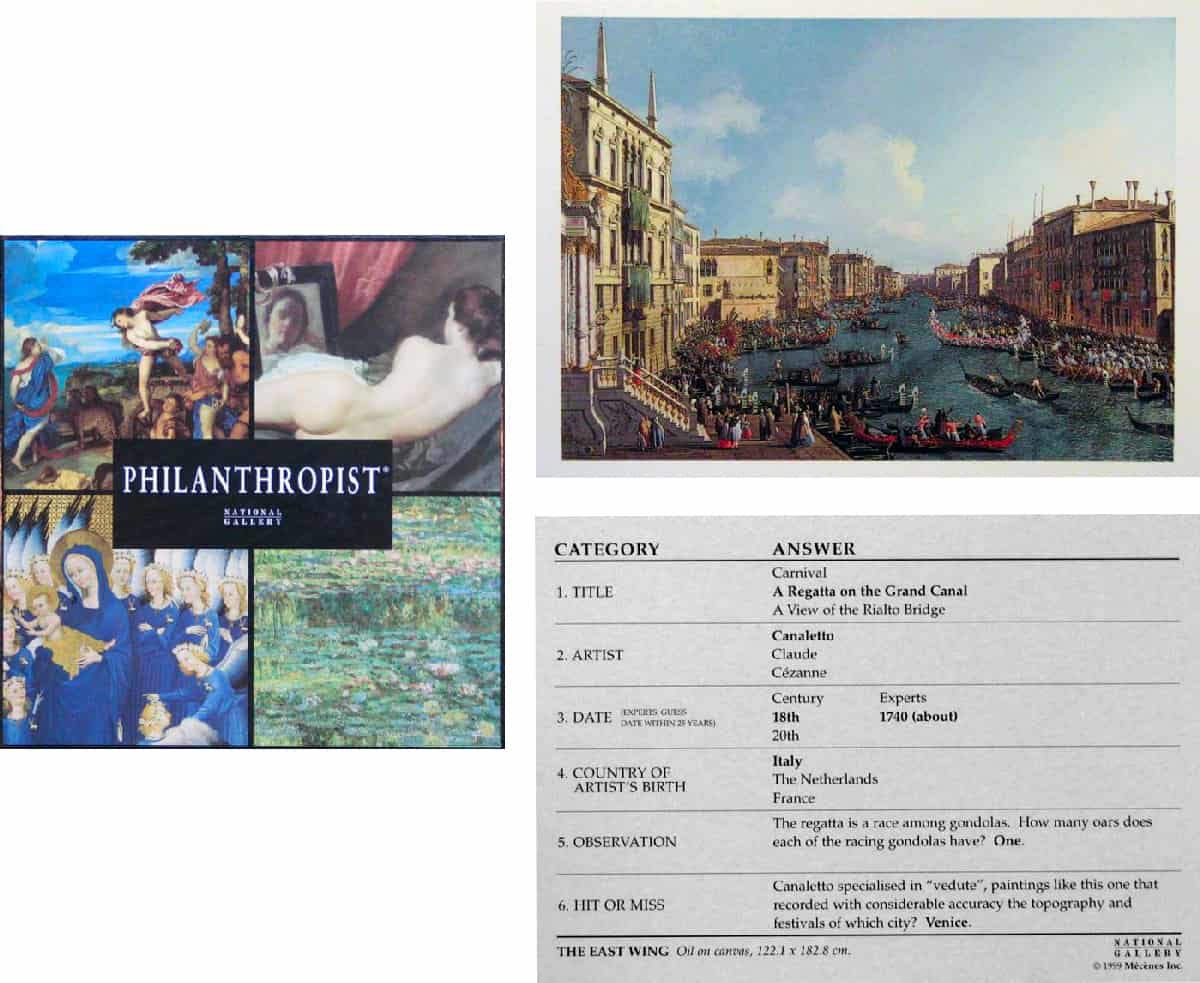
2-4 players
Duration: 45 minutes
Age: 10+
“Philanthropist: The National Gallery ” is the second Western European art history trivia game from Mecenes (the company does not exist anymore. You can find the game used though for instance on ebay), following Philanthropist. It focuses on the artworks of London’s National Gallery.
” is the second Western European art history trivia game from Mecenes (the company does not exist anymore. You can find the game used though for instance on ebay), following Philanthropist. It focuses on the artworks of London’s National Gallery.
The game contains:
- 100 artwork reproductions of paintings on cards
- 52 other cards
- Paper money
- 4 tokens
- Gameboard, rule, dice
Players compete to get and spend their money buying artworks for their gallery by answering questions about paintings (with or without multiple-choice). Correct answers allow players to draw a “Philanthropist” card, with a donation and other consequences.
I really recommend “Philanthropist – National Gallery” to play at home because it has so many strong points for this use :
- The cards have large reproductions of good quality, which enables to also use them to study the artworks themselves.
- The game mechanics are improved compared to “Philanthropist” (players have more options), which makes a really improved “trivia game”.
- The questions being “multiple-choice” (for the players who do not opt to answer straight), you can answer even if you do not know the answer beforehand, by guessing which might be the right one. This enables younger children to play, and also allows people with different levels of art knowledge to play as well.
Philanthropist (Mecenes)
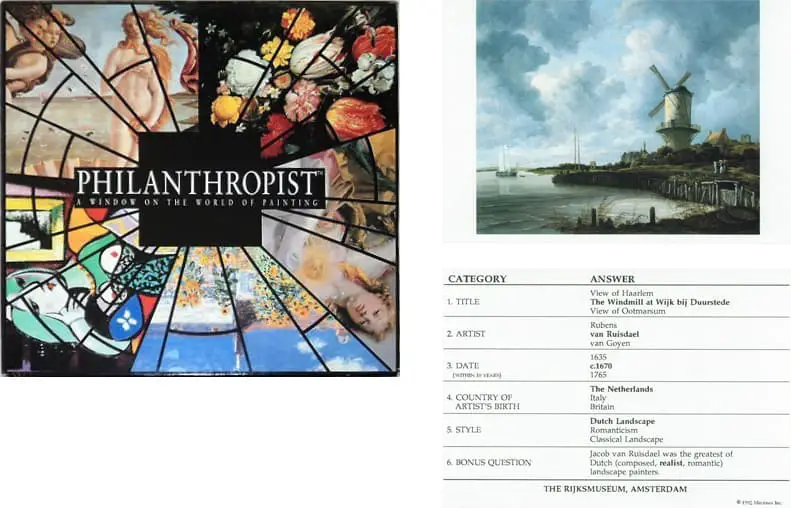
The game is out of print, but you can find it on Ebay .
.
This game is basically the same as “Philanthropist – National Gallery”, except that:
- The artworks are from different museums over the world
- There are 200 artworks rather than 100 for “Philanthropist – National Gallery”
- But: the rules a bit less advanced (it was the first game from “Mécènes”), and there is no “paper money” in the game, instead, there are “jewels” to counts points
The Prestel Art Game (Prestel)
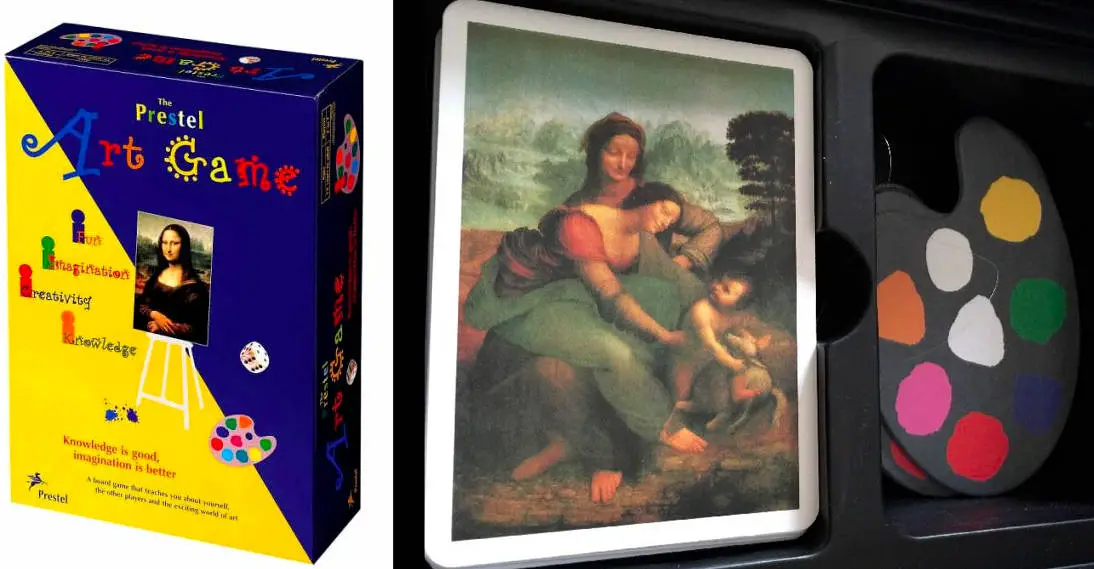
Warning: Prestel does not propose this game anymore. You can buy it online but these are the remaining stock of the game.
3-7 players
Duration: 90 minutes
Age: 12+
The Prestel Art Game aims at making a more varied game than a simple quiz game. The game comprises:
aims at making a more varied game than a simple quiz game. The game comprises:
- 100 Artwork cards from all periods, with the artwork on one side
- A booklet in which all 100 masterpieces reproduced on the picture cards are introduced and described (with thumbnail)
- Decoder: enables to read the answers at the bottom of task and picture cards
- A board, 3 board pieces and a dice (You throw the dice to move the game pieces on the board)
- 84 chips & 7 palettes on which to place the chips
- 7 risk cards
The object of the game is to fill your color palette by completing tasks including:
- Answering a question from the card (some are straight questions, others multiple-answers or “true/false”)
- Brainstorming (players write 3 things they associate with a picture)
- Draw or describe to make the others guess
- “Auction” (in fact little “21” games with numbers)
The caveat with this game is that the players need to have a similar level of knowledge about art history (relies heavily on answering the questions right).
- In the classroom, it can be OK if you select students with a similar level (but the game lasts too long for most real uses in the classroom).
- At home, it is difficult to play with children of different ages.
If you take this into account this aspect of the game and play with a homogeneous group of players, Prestel can be really interesting to play.
Edudingo.com is a participant in the Amazon Services LLC Associates Program, an affiliate advertising program designed to provide a means for sites to earn advertising fees by advertising and linking to Amazon.com. We also participate in other affiliate programs which compensate us for referring traffic.

